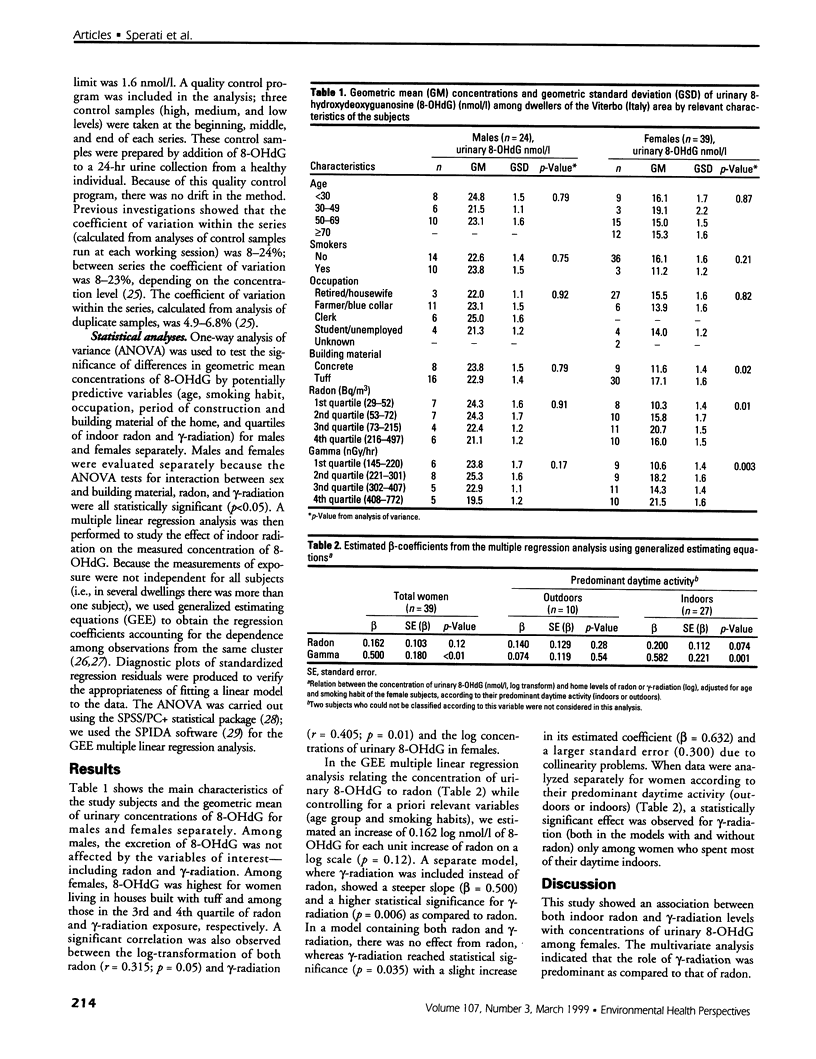Abstract
We investigated whether exposure to indoor [gamma]-radiation and radon might be associated with enough free radical formation to increase urinary concentrations of 8-hydroxydeoxyguanosine (8-OHdG), a sensitive marker of DNA damage, due to a hydroxyl radical attack at the C8 of guanine. Indoor radon and [gamma]-radiation levels were measured in 32 dwellings for 6 months by solid-state nuclear track detectors and thermoluminescent dosimeters, respectively. Urine samples for 8-OHdG determinations were obtained from 63 healthy adult subjects living in the measured dwellings. An overall tendency toward increasing levels of 8-OHdG with increasing levels of radon and [gamma]-radiation was seen in the females, presumably due to their estimated longer occupancy in the dwellings measured. Different models were considered for females, with the steepest slopes obtained for [gamma]-radiation with a coefficient of 0.500 (log nmol/l of 8-OHdG for each unit increase of [gamma]-radiation on a log scale) (p<0.01), and increasing to 0.632 (p = 0.035), but with larger variance, when radon was included in the model. In conclusion, there seems to be an effect of indoor radioactivity on the urinary excretion of 8-OHdG for females, who are estimated to have a higher occupancy in the dwellings measured than for males, for whom occupational and other agents may also influence 8-OHdG excretion. ree radicals; [gamma]-radiation; radon.
Full text
PDF


Selected References
These references are in PubMed. This may not be the complete list of references from this article.
- Bergtold D. S., Berg C. D., Simic M. G. Urinary biomarkers in radiation therapy of cancer. Adv Exp Med Biol. 1990;264:311–316. doi: 10.1007/978-1-4684-5730-8_49. [DOI] [PubMed] [Google Scholar]
- Bridges B. A., Cole J., Arlett C. F., Green M. H., Waugh A. P., Beare D., Henshaw D. L., Last R. D. Possible association between mutant frequency in peripheral lymphocytes and domestic radon concentrations. Lancet. 1991 May 18;337(8751):1187–1189. doi: 10.1016/0140-6736(91)92859-z. [DOI] [PubMed] [Google Scholar]
- Dandona P., Thusu K., Cook S., Snyder B., Makowski J., Armstrong D., Nicotera T. Oxidative damage to DNA in diabetes mellitus. Lancet. 1996 Feb 17;347(8999):444–445. doi: 10.1016/s0140-6736(96)90013-6. [DOI] [PubMed] [Google Scholar]
- Forastiere F., Sperati A., Cherubini G., Miceli M., Biggeri A., Axelson O. Adult myeloid leukaemia, geology, and domestic exposure to radon and gamma radiation: a case control study in central Italy. Occup Environ Med. 1998 Feb;55(2):106–110. doi: 10.1136/oem.55.2.106. [DOI] [PMC free article] [PubMed] [Google Scholar]
- Henshaw D. L., Eatough J. P., Richardson R. B. Radon as a causative factor in induction of myeloid leukaemia and other cancers. Lancet. 1990 Apr 28;335(8696):1008–1012. doi: 10.1016/0140-6736(90)91071-h. [DOI] [PubMed] [Google Scholar]
- Inoue T., Mu Z., Sumikawa K., Adachi K., Okochi T. Effect of physical exercise on the content of 8-hydroxydeoxyguanosine in nuclear DNA prepared from human lymphocytes. Jpn J Cancer Res. 1993 Jul;84(7):720–725. doi: 10.1111/j.1349-7006.1993.tb02035.x. [DOI] [PMC free article] [PubMed] [Google Scholar]
- Kadhim M. A., Lorimore S. A., Hepburn M. D., Goodhead D. T., Buckle V. J., Wright E. G. Alpha-particle-induced chromosomal instability in human bone marrow cells. Lancet. 1994 Oct 8;344(8928):987–988. doi: 10.1016/s0140-6736(94)91643-8. [DOI] [PubMed] [Google Scholar]
- Kasai H., Crain P. F., Kuchino Y., Nishimura S., Ootsuyama A., Tanooka H. Formation of 8-hydroxyguanine moiety in cellular DNA by agents producing oxygen radicals and evidence for its repair. Carcinogenesis. 1986 Nov;7(11):1849–1851. doi: 10.1093/carcin/7.11.1849. [DOI] [PubMed] [Google Scholar]
- Kuchino Y., Mori F., Kasai H., Inoue H., Iwai S., Miura K., Ohtsuka E., Nishimura S. Misreading of DNA templates containing 8-hydroxydeoxyguanosine at the modified base and at adjacent residues. Nature. 1987 May 7;327(6117):77–79. doi: 10.1038/327077a0. [DOI] [PubMed] [Google Scholar]
- Lagorio S., Tagesson C., Forastiere F., Iavarone I., Axelson O., Carere A. Exposure to benzene and urinary concentrations of 8-hydroxydeoxyguanosine, a biological marker of oxidative damage to DNA. Occup Environ Med. 1994 Nov;51(11):739–743. doi: 10.1136/oem.51.11.739. [DOI] [PMC free article] [PubMed] [Google Scholar]
- Liang K. Y., Zeger S. L. Regression analysis for correlated data. Annu Rev Public Health. 1993;14:43–68. doi: 10.1146/annurev.pu.14.050193.000355. [DOI] [PubMed] [Google Scholar]
- Loft S., Vistisen K., Ewertz M., Tjønneland A., Overvad K., Poulsen H. E. Oxidative DNA damage estimated by 8-hydroxydeoxyguanosine excretion in humans: influence of smoking, gender and body mass index. Carcinogenesis. 1992 Dec;13(12):2241–2247. doi: 10.1093/carcin/13.12.2241. [DOI] [PubMed] [Google Scholar]
- Nakajima M., Takeuchi T., Morimoto K. Determination of 8-hydroxydeoxyguanosine in human cells under oxygen-free conditions. Carcinogenesis. 1996 Apr;17(4):787–791. doi: 10.1093/carcin/17.4.787. [DOI] [PubMed] [Google Scholar]
- Nakajima M., Takeuchi T., Takeshita T., Morimoto K. 8-Hydroxydeoxyguanosine in human leukocyte DNA and daily health practice factors: effects of individual alcohol sensitivity. Environ Health Perspect. 1996 Dec;104(12):1336–1338. doi: 10.1289/ehp.961041336. [DOI] [PMC free article] [PubMed] [Google Scholar]
- Sciocchetti G., Clemente G. F., Ingrao G., Scacco F. Results of a survey on radioactivity of building materials in Italy. Health Phys. 1983 Aug;45(2):385–388. doi: 10.1097/00004032-198308000-00011. [DOI] [PubMed] [Google Scholar]
- Shigenaga M. K., Ames B. N. Assays for 8-hydroxy-2'-deoxyguanosine: a biomarker of in vivo oxidative DNA damage. Free Radic Biol Med. 1991;10(3-4):211–216. doi: 10.1016/0891-5849(91)90078-h. [DOI] [PubMed] [Google Scholar]
- Tagesson C., Chabiuk D., Axelson O., Barański B., Palus J., Wyszyńska K. Increased urinary excretion of the oxidative DNA adduct, 8-hydroxydeoxyguanosine, as a possible early indicator of occupational cancer hazards in the asbestos, rubber, and azo-dye industries. Pol J Occup Med Environ Health. 1993;6(4):357–368. [PubMed] [Google Scholar]
- Tagesson C., Källberg M., Klintenberg C., Starkhammar H. Determination of urinary 8-hydroxydeoxyguanosine by automated coupled-column high performance liquid chromatography: a powerful technique for assaying in vivo oxidative DNA damage in cancer patients. Eur J Cancer. 1995 Jun;31A(6):934–940. doi: 10.1016/0959-8049(94)00490-0. [DOI] [PubMed] [Google Scholar]
- Witherell H. L., Hiatt R. A., Replogle M., Parsonnet J. Helicobacter pylori infection and urinary excretion of 8-hydroxy-2-deoxyguanosine, an oxidative DNA adduct. Cancer Epidemiol Biomarkers Prev. 1998 Feb;7(2):91–96. [PubMed] [Google Scholar]


